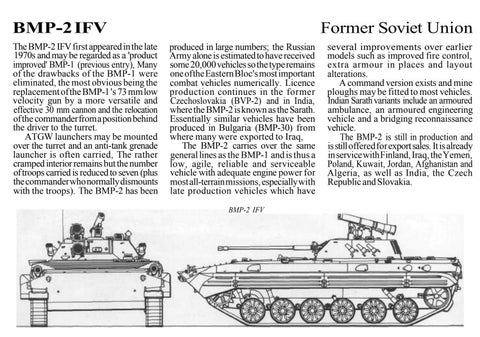BMP-2 IFV The BMP-2 IFV first appeared in the late 1970s and may be regarded as a 'product improved' BMP-1 (previous entry), Many of the drawbacks of the BMP-1 were eliminated, the most obvious being the replacement of the BMP-1 's 73 mm low velocity gun by a more versatile and effective 30 mm cannon and the relocation of the commander from a position behind the driver to the turret. ATGW launchers may be mounted over the turret and an anti-tank grenade launcher is often carried, The rather cramped interior remains but the number of troops carried is reduced to seven (plus the commander who normally dismounts with the troops). The BMP-2 has been
Former Soviet Union produced in large numbers; the Russian Army alone is estimated to have received some 20,000 vehicles so the type remains one of the Eastern Bloc's most important combat vehicles numerically. Licence production continues in the former Czechoslovakia (BVP-2) and in India, where the BMP-2 is known as the Sarath. Essentially similar vehicles have been produced in Bulgaria (BMP-30) from where many were exported to Iraq, The BMP-2 carries over the same general lines as the BMP-1 and is thus a low, agile, reliable and serviceable vehicle with adequate engine power for most all-terrain missions, especially with late production vehicles which have BMP-2 IFV
several improvements over earlier models such as improved fire control, extra armour in places and layout alterations. A command version exists and mine ploughs may be fitted to most vehicles. Indian Sarath variants include an armoured ambulance, an armoured engineering vehicle and a bridging reconnaissance vehicle. The BMP-2 is still in production and is still offered for export sales. It is already in service with Finland, Iraq, the Yemen, Poland, Kuwait, Jordan, Afghanistan and Algeria, as well as India, the Czech Republic and Slovakia.

















































